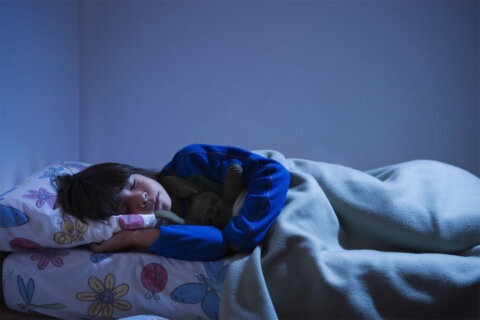As spring temperatures begin warming up and children start spending more time outside, a D.C. dermatologist has tips for parents to protect kids from bug bites and getting sunburned.
“Sunscreen alone is never really going to get the job done,” said Dr. Anna Yasmine Kirkorian, the chief of dermatology at Children’s National Hospital. “Sunscreen is just one important part of how to prevent sunburn.”
“Sun protective clothing will go a far longer way than really much else,” she said.
Talking about long-sleeved rash guards, wide-brimmed hats, pants and other sun-protective clothing, Kirkorian said they can be found reasonably priced and are made for infants and adults.

For areas that can’t be covered with clothing, be sure to cover with sunscreen. That would include the face, ears, neck, hands and exposed parts of the lower extremities and feet.
Another protective strategy is to seek shade, particularly during the midday hours between 10 a.m. and 3 p.m.
The most common mistakes people make that lead to sunburns include relying solely on sunscreen, failing to put enough on when using sunscreen, and not reapplying sunscreen frequently enough.
“So you really want to apply a sufficient quantity, but you also need to reapply if you’ve been sweating or been in water. And again, that’s where the clothing plays an important role; because the less area you have to cover, the more likely you are to successfully [protect] those areas,” she said.
Kirkorian said that childhood sun exposure is associated with a higher risk of skin cancer in adulthood, so preventing burns is critical for children in particular.
If protective measures fail and a kid gets sunburned, when is it something to be concerned about?
“If it’s your more typical sunburn, you can do measures at home, such as cool compresses and soothing lotions, and avoid further sun exposure in those areas,” Kirkorian said. “But if the child is systemically ill or there are blisters, you do want to seek medical attention.”
Spring skin care also involves avoiding and repelling insects to avoid bites.
“Children tend to have more intensive reactions to bug bites than adults,” Kirkorian said.
What’s commonly called skeeter syndrome, involves an intense reaction to bug bites that includes hives or red, itchy, painful swelling.
To minimize exposure, Kirkorian recommends avoiding being outdoors at dusk — when insects tend to be more active with bites — dumping water sources where mosquitoes breed, wearing protective clothing especially when hiking to avoid ticks, and using child-appropriate bug sprays with ingredients, such as DEET or picaridin, applied to clothing and only on exposed skin — not under clothing.
There are bugs sprays that are specifically meant for children and approved by the American Academy of Pediatrics, which also has recommendations for application.
“And lastly, we do not recommend combined products — like products that contain both sunscreen and insect repellent — because we want to apply sunscreen frequently and we don’t want to reapply insect repellent multiple times a day,” she said.
As for itchy, bug bites a child hasn’t been able to resist scratching?
“If a child has severe inflammatory responses to bug bites, it is a good idea to see your primary care physician, an allergist or a dermatologist because sometimes we can prescribe certain medications that are prescription,” Kirkorian said. “What we want to prevent is the children scratching so intensely that they break the skin because that can lead to scarring and put them at risk for infection. So if a child has many, many bug bites or seems to have exaggerated bug bites then I think it is a good idea to go ahead and seek medical care with a physician.”
But typically, comfort can come from soothing compresses and/or anti-itch lotions that would allow the bug bite to resolve naturally and heal on its own in time.
Amid this discussion about precautionary measures, Kirkorian stresses that the outdoors can be enjoyed safely with the use of sun-protective clothing, sunscreen and bug spray. She does not want the importance of outdoor play for children’s health and mental well-being to get lost.
“It’s so important for children to be outside. One of the most important things for pediatric health is to go outside, enjoy the park,” she said. “And so, I want children to be encouraged to be outside. If it can be 30 minutes to an hour per day, it would be ideal.”






